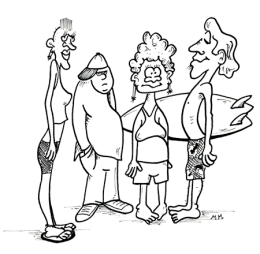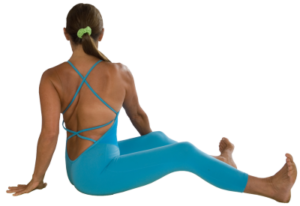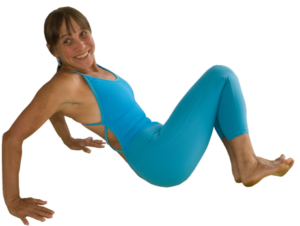ALIGNING POSTURE IS A POWERFUL HEALING EXPERIENCE
Ronald Peters, MD, MPH
 After decades of sitting, slouching, leaning forward, and gazing at my computer, I developed painful osteoarthritis of my left hip. Determined to practice my own medicine and learn from the messages from my body, I launched myself into the therapeutic wonderland of alternative medicine: chiropractic, massage, acupuncture, Feldenkrais, and more. Each therapy provided a bit of success, but nothing worked as quickly as Michaelle Edwards’ training program, YOGALIGN: PAIN-FREE YOGA FROM YOUR INNER CORE.
After decades of sitting, slouching, leaning forward, and gazing at my computer, I developed painful osteoarthritis of my left hip. Determined to practice my own medicine and learn from the messages from my body, I launched myself into the therapeutic wonderland of alternative medicine: chiropractic, massage, acupuncture, Feldenkrais, and more. Each therapy provided a bit of success, but nothing worked as quickly as Michaelle Edwards’ training program, YOGALIGN: PAIN-FREE YOGA FROM YOUR INNER CORE.
Her pioneering work is based on an integration of the muscles, fascia and bones throughout the body with consciousnesses guided by the fundamental and yet mysterious process of breath. As I listened to my breath, my posture improved and the sensations in my hip changed. It seemed to be a natural alignment.
In conventional medicine, we focus on parts of the body, regions of our anatomy, as we listen to specialists. But I know from 35 years of integrative medical practice that promoting health throughout the body and mind holistically is more likely to produce healing. Michaelle’s experience with yoga clients showed her the powerful integration of the bones and muscles as they keyed with breath and posture. Her exercises are improving my posture which takes pressure off my left hip and opens the joint space so it can heal. Afterall, the body is a healing machine.
Pain in the back, hips and knees is a signal of misalignment, or poor posture, and using her training empowers people to eliminate the pain and restore freedom of movement and vitality.
The following information is taken from her website: https://yogalign.com/
YOGALIGN IS . . .
- Yoga practice for optimal alignment using painless and safe body positions and poses
- Unique breathing techniques that tone the core and align posture from the inside out
- Self-massage to stimulate blood flow, nourish tissues and increase kinesthetic awareness
- Fascial freedom of the connective tissue web – a major determinant of our posture, movement and even our moods
- Full body flexibility/strength balance techniques that simultaneously increase efficiency of muscle chains and functional ROM (range of motion)
- Neuromuscular re-patterning techniques encoding aligned posture at the nervous system level
- Activating the psoas/diaphragm connection for core centered movement, enhanced breathing, organ support, and emotional balance
- Global body awareness and ability to meditate in movement directing consciousness in the present moment
- Kindness, compassion and non-judgment towards self and others
- Impeccable in thoughts, speech, and actions
POOR POSTURE IS EPIDEMIC

There is an epidemic of poor posture in the Western world; most people shrink in height and go forward into the C-shape spine as they age. Some of the many disorders linked to this C-shaped postural dysfunction are depression, anxiety, weight gain, chronic pain, headaches, osteo-arthritis, vertigo, vision disorders, joint failures, incontinence, digestion, and premature aging

Poor posture is now common in teenagers
ALIGNED POSTURE IS THE FOCUS OF YOGALIGN
 What naturally aligned posture does ……
What naturally aligned posture does ……
- Opens up biological pathways that increase feelings of happiness
- Keeps your energy level high and can boost confidence
- Lowers fear, depression and anxiety
- Makes you more productive
- Optimizes breathing and movements
- Supports optimal functioning of the integumentary, skeletal, nervous, cardiovascular, endocrine, digestive, elimination, immune, respiratory, digestion, muscular and fascial system
What naturally aligned posture looks like.
 WHAT IS FASCIA AND HOW DOES IT AFFECT POSTURE?
WHAT IS FASCIA AND HOW DOES IT AFFECT POSTURE?
Fascia Research Congress defines fascia as all collagenous fibrous connective tissues that can be seen as elements of a body-wide tensional force transmission network. Most fascia tissue is composed of collagen except for a few elastin fibers and together they link every part of your body together as one cohesive structure.
On the right is an example of muscle/fascia forces in balance. This is the superficial front or flexor line with the opposing line of pull; the superficial back or extensor line. In the Western world, very few people actually have naturally aligned posture and healthy muscle/fascia patterning that looks like this.
GET YOUR KID BODY BACK
 YogAlign breathing develops your core center while at the same time allowing you to feel and engage your body in its entirety. As you develop better body awareness and learn to move from your core breathing line, good posture simply becomes innate. Similar to a ‘default’ program on a computer, this aligned posture ‘software’ is uploaded to the autonomic nervous system where individual posture and movement habits occur without our conscious control.
YogAlign breathing develops your core center while at the same time allowing you to feel and engage your body in its entirety. As you develop better body awareness and learn to move from your core breathing line, good posture simply becomes innate. Similar to a ‘default’ program on a computer, this aligned posture ‘software’ is uploaded to the autonomic nervous system where individual posture and movement habits occur without our conscious control.
YogAlign creates efficient wiring in the nervous system programs responsible for signaling muscle and fascia fibers how and when to contract. YogAlign is easy for anyone of any age or fitness level. Students report that they feel energized, youthful and lifted in the very first class. We call it getting your kid body back.
Babies have good posture because they have not yet been forced to sit in chairs in a right-angle body position.
WOMEN GET 80% OF ALL HIP SURGERIES
Women get 80% of all hip surgeries in the US and quite possibly the biggest reason could be laxity in the joint itself. Women are naturally more flexible than men and have hormones that create more laxity in the hips during pregnancy and childbirth. Practicing hip openers and forward bends can create even more laxity in the hips, sacrum and spinal column. Ligament tension is necessary for stability as these joints assist us in being upright. These are some of the biggest reasons for the injuries and hip joint surgeries that are becoming more frequent in the yoga world.
 YOGALIGN GIVES YOU BACK ‘LOST REAL ESTATE’ IN YOUR BODY.
YOGALIGN GIVES YOU BACK ‘LOST REAL ESTATE’ IN YOUR BODY.
The YogAlign breathing method restores the inner expansive spaciousness of the rib cage, chest and torso area. Most people in the Western World never breathe deeply enough to engage muscles that expand and support the lift of the rib cage. Breathing muscles are also posture muscles that help keep us upright. As the breathing muscles atrophy, the rib cage collapses and the head comes forward of the spine which creates the C-shape or spine flexion that leads to premature aging, chronic pain, anxiety and loss of ‘real estate’ in the height and breadth of the torso.
BREATHE YOUR WAY TO A PAIN-FREE LIFE
 Most of the ‘breakdowns’ and chronic pain patterns in the human body occur in the joints. When you change alignment patterns, joints are no longer compressed and misaligned, so the real healing by the body itself can happen on a deep level.
Most of the ‘breakdowns’ and chronic pain patterns in the human body occur in the joints. When you change alignment patterns, joints are no longer compressed and misaligned, so the real healing by the body itself can happen on a deep level.
As you gain the tools that will connect all parts of your body with better oxygenation, nutrition and proper alignment, the bio-intelligence can then heal the joint tissues that have become thin, damaged or arthritic. The best way to do YogAlign is to walk, run, dance or move with a focus on maintaining upright posture. Eventually naturally aligned posture becomes innate and just the way you are naturally…. without effort.
With YogAlign you can get back into good posture without painful positions, compressive twists or toe touching poses. You can literally breathe your way to a pain-free life.
YOGALIGN: PAIN-FREE YOGA FROM YOUR INNER CORE
Karla Rodas {Book Review}, April 27, 2014
“The YogAlign method works at the nervous system level, creating almost immediate transformation to a pain-free state of being in the body without effort.”
Quite a claim to live up to, I thought, but I was determined to keep an open mind because there’s value in learning something new. The title resonated with me, “pain-free yoga,” this piqued my interest right away because who wouldn’t want to be pain-free?
The YogAlign program, developed by Michealle Edwards, has been over 20 years in the making as a result of countless hours spent on her own mat and working as a movement therapist.
She incorporates her experiences as a massage therapist and yoga teacher, specializing in working with clients suffering from pain and misalignment to create a set of tools that anyone can utilize. A serious knee ligament injury had a huge impact on her yoga practice and this prompted her research into how some of the traditional yoga postures were causing more harm than good.
No scare tactics or infomercial pitches here but there are several case studies and before and after photos of personal clients. She began a serious investigation into how the body works as a whole and admits that what many of the techniques that she has developed “are the opposite of what [she] was originally taught to do in yoga and stretching classes-and for good reason.”
 The YogAlign book contains over 300 pages worth of theory, anecdotes, an anatomical road map, illustrations and a practice DVD including a full-length yoga class and further explanation of the unique YogAlign system.
The YogAlign book contains over 300 pages worth of theory, anecdotes, an anatomical road map, illustrations and a practice DVD including a full-length yoga class and further explanation of the unique YogAlign system.
Edwards credits our poor posture and sedentary lifestyle as some of the underlying causes of losing our “innate kid body,” our lack of freedom in our movement and breathing processes. Her answer is to “re-pattern the neuromuscular wiring, enabling you to acquire optimal alignment on an innate and intrinsic level.”
YogAlign identifies the fascia, connective tissues of the body, as the true supportive foundational structure of our bodies. “Quality of our breath, our movements, our posture and even our moods are defined by the elasticity of our fascia.”
The analogy of an orange when it is peeled and the skin removed, continues to hold its shape because of the white cellulose holding the fruit intact, much like our fascia that determines our shape, structure and movement. This explanation helped me to visualize it and understand it in a different way. This is extremely helpful for yoga instructors, body workers and movement therapists are the illustrations included along with detailed explanation of the fascial lines of the body.
The illustrations are done by Thomas Myers, author of Anatomy Trains. These were an exceptional accompaniment to the side-by-side photo illustrations of YogAlign postures and explanations of each of the fascial lines throughout the body. This made it a valuable reference for me as a yoga instructor because I’d be able to have both the written and the visual resources to go back when I needed to.
What I noted as unique is that in the aptly named section, Yoga doesn’t have to hurt, the traditional yoga postures that put the body into a right-angle position are eliminated altogether and “not recommended in YogAlign because it restricts the internal movements of breathing and does not simulate how a human body moves in real life.”
Included are photo illustrations of how postures such as seated forward bend done traditionally makes no sense because it shortens the front of the body in order to stretch the back and “exacerbates alignment and pain issues” that already exist.
Instead, she offers modifications using the YogAlign principles that we need to honor our wisdom and respect the bodies we are in, including the natural spinal curves. Postures not recommended for safety reasons is a section found at the back of the book that restates the YogAlign philosophy that we should be able to breathe freely and be pain-free while practicing yoga.
Mitch
5 STARS – Simply outstanding
I practiced yoga consistently for 11 years, primarily as a form of treating problems with two badly aggravated discs in the center of my back. The discs caused stinging and aching pain in my back at some point almost every day, especially when bearing weight or doing strenuous exercise.
Yoga (mostly Vinyasa at a studio or a “flow” class at my gym) would sometimes bring relief to those symptoms, sometimes not. But when it didn’t, I assumed it was my fault. I wasn’t being consistent enough, not doing yoga “right.”
I also assumed that when I couldn’t achieve a given yoga pose, even after weeks or months of building towards it, it was because I wasn’t “relaxing into the pose” or “breathing into the pose” properly, not “going deep enough.” The purpose of yoga felt, in essence, to be: “learn to meditate and relax while you’re in serious physical discomfort, if not pain.”
But no matter how much I “relaxed into the discomfort,” I could neither gain much flexibility, nor could I find lasting relief for the problems with my back. Physical therapy, especially Gyrotonic, was effective, but not practical for me to do every day.
One night a few weeks ago, I returned home from a yoga class where I had felt significant pain doing standing forward folds and seated forward folds. After over a decade of effort, I could feel that I was essentially not “getting anywhere” with yoga. Not gaining flexibility, improving my balance, finding freedom from pain, lift in my spine, etc. Instead of feeling liberated in my body, I felt depleted, achy and creaky.
Also, while I enjoy the spiritual and meditative aspect of yoga, no matter how many times teachers told me to suspend judgment of myself, make my practice my own, etc., let’s face it: it’s demoralizing and frustrating to watch people achieve a pose the way it’s supposed to be done when you can’t. And there is definitely a way it’s supposed to be done, whether it’s how the teacher demonstrates it, how your neighbor does it, or how the diagrams on the studio wall depict it. Rather than gradually learning to “accept myself,” I always felt inadequate.
After that last class, I did some Googling for “yoga alternatives,” which led me very quickly to YogAlign. I reviewed the videos on Michaelle’s YouTube channel, and was very curious.
I called the number on the YogAlign website. Lo and behold, Michaelle herself answered immediately!
I explained my back symptoms, and my frustrations with yoga. Michaelle listened with total understanding. She described the YogAlign process, how it departs from yoga as it’s taught as a form of exercise to most people in the modern world, and how she developed it based on extensive anatomical research, and rigorous trial and error. We had a long and friendly chat, after which I purchased this book right away.
The book contains a lot of information about why Michaelle takes issue with aspects of how yoga is taught, and a lengthy explanation of human anatomy and how our body creates posture. It’s very interesting, but by the time I was about halfway through the book, I felt ready to roll.
After a single session of the routine on the DVD that comes with the book, I felt more free of aches and pains, more fluid in my movements, and more able to breathe naturally and effortlessly, than I had in years.
The next day, even though the routine is vigorous definitely makes you sweat, I was so free of any soreness that I did it again immediately. Not to mention I was instantly more flexible. I could almost bring my leg to my forehead while it was fully extended, which was something I never been able to achieve in yoga classes. The benefits have continued to accumulate.
This is not a gimmick. For someone who needs freedom from pain and discomfort, as well as increased mobility and support for other physical activities, this is the one. Her inclusion of self-massage even helped my feet ache less on long walks.
Honestly, I’m surprised this hasn’t taken off like wildfire. If you really like yoga, as I still do, but want to be able to practice it in a way that’s not depleting, painful, or frustrating, but instead nourishes your body, I can’t recommend highly enough.





